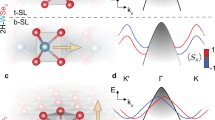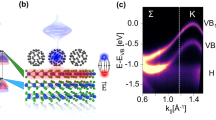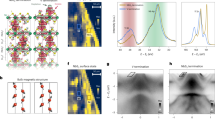Abstract
Methods to generate spin-polarized electronic states in non-magnetic solids are strongly desired to enable all-electrical manipulation of electron spins for new quantum devices1. This is generally accepted to require breaking global structural inversion symmetry1,2,3,4,5. In contrast, here we report the observation from spin- and angle-resolved photoemission spectroscopy of spin-polarized bulk states in the centrosymmetric transition-metal dichalcogenide WSe2. Mediated by a lack of inversion symmetry in constituent structural units of the bulk crystal where the electronic states are localized6, we show how spin splittings up to ∼0.5 eV result, with a spin texture that is strongly modulated in both real and momentum space. Through this, our study provides direct experimental evidence for a putative locking of the spin with the layer and valley pseudospins in transition-metal dichalcogenides7,8, of key importance for using these compounds in proposed valleytronic devices.
This is a preview of subscription content, access via your institution
Access options
Subscribe to this journal
Receive 12 print issues and online access
$259.00 per year
only $21.58 per issue
Buy this article
- Purchase on SpringerLink
- Instant access to full article PDF
Prices may be subject to local taxes which are calculated during checkout


 –
– –
– .
.

Similar content being viewed by others
References
Koo, H. C. et al. Control of spin precession in a spin-injected field effect transistor. Science 325, 1515–1518 (2009).
Hsieh, D. et al. A topological Dirac insulator in a quantum spin Hall phase. Nature 452, 970–974 (2008).
Bahramy, M. et al. Emergent quantum confinement at topological insulator surfaces. Nature Commun. 3, 1159 (2012).
Murakawa, H. et al. Detection of Berry’s phase in a bulk Rashba semiconductor. Science 342, 1490–1493 (2013).
Mourik, V. et al. Signatures of Majorana fermions in hybrid superconductor–semiconductor nanowire devices. Science 336, 1003–1007 (2012).
Zhang, X., Liu, Q., Luo, J. W., Freeman, A. J. & Zunger, A. Hidden spin polarization in inversion-symmetric bulk crystals. Nature Phys. 10, 387–393 (2014).
Gong, Z. et al. Magnetoelectric effects and valley-controlled spin quantum gates in transition metal dichalcogenide bilayers. Nature Commun. 4, 2053 (2013).
Jones, A. M. et al. Spin-layer locking effects in optical orientation of exciton spin in bilayer WSe2 . Nature Phys. 10, 130–134 (2014).
Datta, S. & Das, B. Electronic analog of the electro-optic modulator. Appl. Phys. Lett. 56, 665–667 (1990).
Das, T. & Balatsky, A. V. Engineering three-dimensional topological insulators in Rashba-type spin–orbit coupled heterostructures. Nature Commun. 4, 1972 (2013).
Zhou, J. J., Feng, W., Zhang, Y., Yang, S. A. & Yao, Y. Engineering topological surface states and giant Rashba spin splitting in BiTeI/Bi2Te3 heterostructures. Sci. Rep. 4, 3841 (2014).
Bychkov, Y. A. & Rashba, E. I. Properties of a 2D electron gas with lifted spectral degeneracy. JETP Lett. 39, 78–81 (1984).
Nitta, J., Akazaki, T., Takayanagi, H. & Enoki, T. Gate control of spin–orbit interaction in an inverted In0.53Ga0.47As/In0.52Al0.48As heterostructure. Phys. Rev. Lett. 78, 1335–1338 (1997).
Ast, C. R. et al. Giant spin splitting through surface alloying. Phys. Rev. Lett. 98, 186807 (2007).
King, P. D. C. et al. Large tunable Rashba spin splitting of a two-dimensional electron gas in Bi2Se3 . Phys. Rev. Lett. 107, 096802 (2011).
King, P. D. C. et al. Quasiparticle dynamics and spin–orbital texture of the SrTiO3 two-dimensional electron gas. Nature Commun. 5, 3414 (2014).
Dresselhaus, G. Spin–orbit coupling effects in zinc blende structures. Phys. Rev. 100, 580–586 (1955).
Ishizaka, K. et al. Giant Rashba-type spin splitting in bulk BiTeI. Nature Mater. 10, 521–526 (2011).
Xiao, D., Liu, G-B., Feng, W., Xu, X. & Yao, W. Coupled spin and valley physics in monolayers of MoS2 and other Group-VI dichalcogenides. Phys. Rev. Lett. 108, 196802 (2012).
Mak, K. F., He, K., Shan, J. & Heinz, T. F. Control of valley polarization in monolayer MoS2 by optical helicity. Nature Nanotech. 7, 494–498 (2012).
Zeng, H., Dai, J., Yao, W., Xiao, D. & Cui, X. Valley polarization in MoS2 monolayers by optical pumping. Nature Nanotech. 7, 490–493 (2012).
Finteis, T. et al. Occupied and unoccupied electronic band structure of WSe2 . Phys. Rev. B 55, 10400–10411 (1997).
Zhu, Z-H. et al. Layer-by-layer entangled spin–orbital texture of the topological surface state in Bi2Se3 . Phys. Rev. Lett. 110, 216401 (2013).
Zhu, Z-H. et al. Photoelectron spin–polarization control in the topological insulator Bi2Se3 . Phys. Rev. Lett. 112, 076802 (2014).
Bihlmayer, G. et al. Enhanced Rashba spin–orbit splitting in Bi/Ag(111) and Pb/Ag(111) surface alloys from first principles. Phys. Rev. B 75, 195414 (2007).
Yuan, H. et al. Zeeman-type spin splitting controlled by an electric field. Nature Phys. 9, 563–569 (2013).
Jones, A. M. et al. Optical generation of excitonic valley coherence in monolayer WSe2 . Nature Nanotech. 8, 634–638 (2013).
Zhang, Y. J., Oka, T., Suzuki, R., Ye, J. T. & Iwasa, Y. Electrically switchable chiral light-emitting transistor. Science 344, 725–728 (2014).
Xu, X., Yao, W., Xiao, D. & Heinz, T. F. Spin and pseudospins in layered transition metal dichalcogenides. Nature Phys. 10, 343–350 (2014).
Berntsen, M. H. et al. A spin- and angle-resolving photoelectron spectrometer. Rev. Sci. Instrum. 81, 035104 (2010).
Blaha, P. et al. WIEN2K package, Version 10.1 (2010); http://www.wien2k.at
Souza, I. et al. Maximally localized Wannier functions for entangled energy bands. Phys. Rev. B 65, 035109 (2001).
Mostofi, A. A. et al. Wannier90: A tool for obtaining maximally localised Wannier functions. Comput. Phys. Commun. 178, 685–699 (2008).
Kuneš, J. et al. WIEN2WANNIER: From linearized augmented plane waves to maximally localized Wannier functions. Comput. Phys. Commun. 181, 1888–1895 (2010).
Acknowledgements
We gratefully acknowledge support from the Engineering and Physical Sciences Research Council, UK, the VILLUM foundation, the Calipso program, TRF-SUT Grant RSA5680052 and NANOTEC, Thailand through the CoE Network. P.D.C.K. acknowledges support from the Royal Society through a University Research Fellowship. M.S.B. was supported by a Grant-in-Aid for Scientific Research (S) (No. 24224009) from the Ministry of Education, Culture, Sports, Science and Technology (MEXT) of Japan. The experiments at the MAX IV Laboratory were made possible through funding from the Swedish Research Council and the Knut and Alice Wallenberg Foundation.
Author information
Authors and Affiliations
Contributions
J.M.R., F.M., M.D., M.M., L.B., C.G., W.M., J.W.W. and P.D.C.K. measured the experimental data. J.M.R., F.M., J.W.W. and P.D.C.K. analysed the data. M.S.B. performed the electronic structure calculations. T.T. grew the samples. M.L. and T.B. maintained the spin-ARPES end stations and M.H. and T.K.K. maintained the ARPES end stations, respectively, and provided experimental support. P.D.C.K., J.W.W., M.S.B., P.H. and H.T. provided the project infrastructure. All authors discussed the results and their interpretation. P.D.C.K. and J.M.R. wrote the manuscript with input and discussion from all co-authors. P.D.C.K. was responsible for overall project planning and direction.
Corresponding author
Ethics declarations
Competing interests
The authors declare no competing financial interests.
Supplementary information
Supplementary Information
Supplementary Information (PDF 3048 kb)
Rights and permissions
About this article
Cite this article
Riley, J., Mazzola, F., Dendzik, M. et al. Direct observation of spin-polarized bulk bands in an inversion-symmetric semiconductor. Nature Phys 10, 835–839 (2014). https://doi.org/10.1038/nphys3105
Received:
Accepted:
Published:
Issue date:
DOI: https://doi.org/10.1038/nphys3105
This article is cited by
-
Uncovering spin-orbit coupling-independent hidden spin polarization of energy bands in antiferromagnets
Nature Communications (2023)
-
Unconventional hidden Rashba effects in two-dimensional InTe
npj 2D Materials and Applications (2023)
-
Hydrogenic spin-valley states of the bromine donor in 2H-MoTe2
Communications Physics (2023)
-
Large spin–orbit torque in bismuthate-based heterostructures
Nature Electronics (2023)
-
Giant valley-Zeeman coupling in the surface layer of an intercalated transition metal dichalcogenide
Nature Materials (2023)



